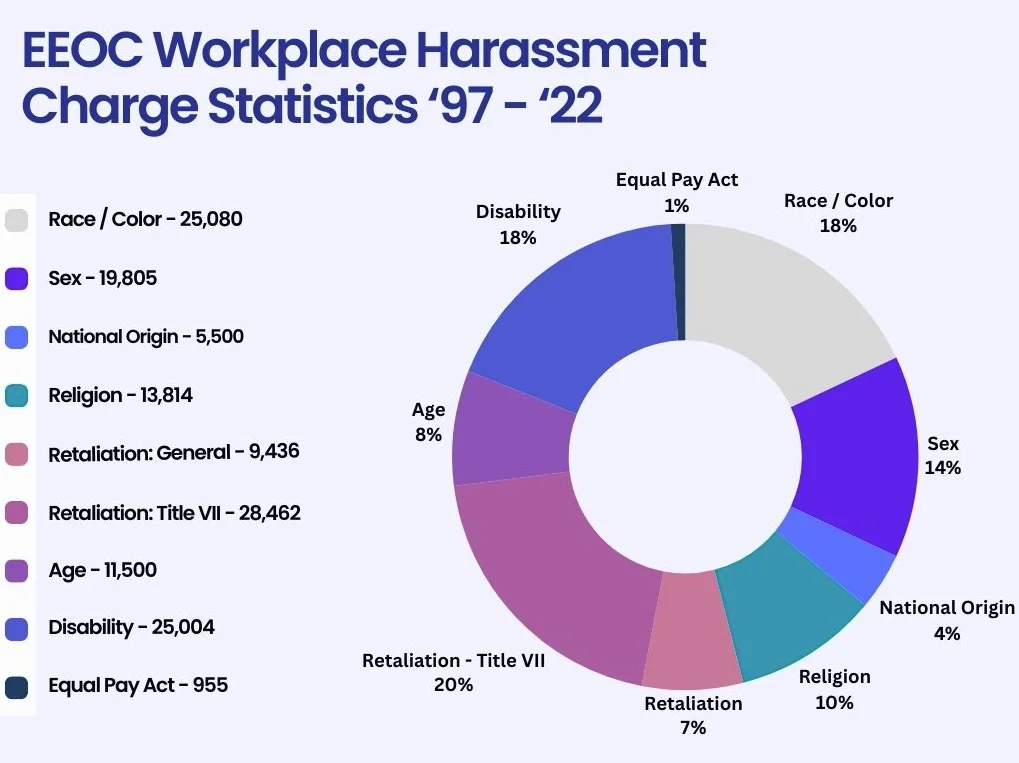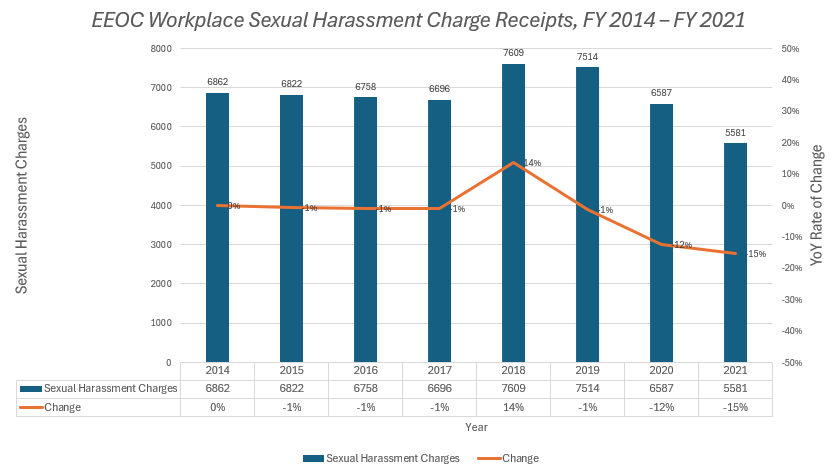Examples of workplace harassment often involve unwelcome and hostile behavior that can include the use of slurs, comments about someone’s gender or religion, offensive jokes, and sexual advances. In many cases, there may even be several overlapping forms of harassment going on. Incidents of workplace harassment typically involve conduct towards another individual in the workplace that is not welcome or appropriate. These actions are sometimes a result of discrimination against a protected minority class. When this occurs, these acts of employment discrimination are in violation of anti-discrimination laws which are unlawful. The laws that prohibit unlawful activities like workplace harassment and discrimination include but are not limited to the California Fair Employment and Housing Act and the federal Civil Rights Act, Age Discrimination in Employment Act, and the Americans with Disabilities Act.
What is Workplace Harassment?
The dictionary defines harassment as aggressive pressure or intimidation. It is also known as repetitive actions meant to bother someone. Unlawful harassment in the workplace is defined by strict guidelines [1]:
- The behavior must be unwanted and unwelcome
- The behavior must be based on or motivated by a protected characteristic such as the victim’s race or gender
- The behavior must be abusive
- The behavior must be severe enough that it creates a hostile or abusive work environment by objective and reasonable standards
Workplace harassment may also be unlawful if the employer is informed of the harassment and refuses to take action to stop or prevent it.
If your employment rights have been violated, call us today at (866) 936 7349 to schedule a free consultation
Workplace Harassment Laws
There are many laws in place to protect employees from workplace harassment and discrimination.
- Equal Pay Act [2] – forbids employers from paying male and female employees different wages for the same work
- Age Discrimination Act [3] – that forbids employers from discriminating against employees over 40 due to their age
- Americans with Disabilities Act [4] – protects disabled individuals from harassment and discrimination
- Civil Rights Act [5] – forbids employers from discriminating against employees due to their race, religion, or sex
State and federal laws are a major part of preventing discrimination and harassment on a large scale. However, it is equally important that individual workplaces have their own guidelines and policies that are clearly communicated and consistently enforced. These practices not only foster a healthy work environment for the employees, but they also help the employer avoid adverse legal action.
Examples of Workplace Harassment
Workplace harassment is a term that encompasses many different types of harassment that an employee may experience from their coworkers or employers. Some examples of workplace harassment may include but are not limited to [6]:
Interference with work performance – When a boss or worker makes it difficult or impossible for the employee to complete their work. This may include denying the employee access to necessary equipment or deliberately delaying the work from being completed.
Displaying offensive objects or pictures – When a boss or worker shares or displays material that is racially insensitive, sexually explicit, or in some other way offends their coworkers. A single unintentional incident may not qualify as harassment, but if they are spoken to and do not stop or they remove the item only to replace it with something similar, it may then be considered harassment.
Offensive language or jokes– When a boss or worker makes derogatory jokes, uses slurs, or otherwise makes offensive comments or jokes regarding protected characteristics such as race, gender, religion, or sexuality.
Insults and mockery – When a boss or worker make fun of an employee or imitates them in a derogatory way. This can also include putting someone down for their intelligence or appearance.
Physical threats and assault – When a boss or worker deliberately make physical contact or threatens physical contact in a way meant to frighten an employee, such as aggressively bumping into them or blocking their path.
Intimidation – When a boss or worker verbally abuses an employee in an effort to damage their self-esteem. This can include overworking an employee to impossible standards, setting them up to fail and then ridiculing them when they do, and taking credit for their hard work.
Exclusion – When a boss or worker deliberately excludes an employee from meetings, events, social gatherings, and advancement opportunities.
Types of Harassment in the Workplace
There are several types of harassment that can occur in the workplace. The following are all unlawful and violate CA employment laws:
Discriminatory Harassment
The defining factor of discriminatory harassment is the motivations behind it [7]. In the state of California, it is a public policy violation for your employer to discriminate or harass you for your:
- Age
- Disability
- Gender
- Genetic Information
- Marital Status
- Medical Status
- Military Status
- National Origin
- Pregnancy
- Race
- Religion
- Sexual Orientation
The chart below indicates the share of workplace harassment charges based on discrimination type filed between 1997 – 2022 [8].

Racial Harassment
When someone is harassed based on their race, ethnicity, or national origin, they may be subjected to slurs, insulting remarks, mockery, and offensive jokes. A person may not even belong to the ethnicity in question, but their harasser thinks they are. While we have come a long way since the time of racial segregation, recent studies conducted by the Gallup Center have shown that approximately 25% percent of black and Hispanic workers experience workplace harassment whereas the number of white people that felt discriminated against was only 15%. Of that, 75% of black people and 61% of Hispanic people in the study reported that the discrimination they experienced was racially motivated [9], while white people reported 42% of cases being racially motivated. It is also common for harassment to escalate over time.
Gender Harassment
There are many ways that workers may encounter sex and gender based harassment. Men may be ridiculed for being in a career that is seen as being only for women. Women in leadership positions often face intimidation and exclusion. Being harassed due to pregnancy or breastfeeding is also considered a form of sex discrimination. Sometimes, male workers will make comments or share material that is degrading to women and offensive to their female coworkers. Transgender and nonbinary employees often face many forms of discrimination and harassment such as insulting remarks, lack of access to restrooms, and misgendering.
Religious Harassment
Religious harassment can occur overtly in the form of outright religious discrimination or in more subtle ways that are considered microaggressions that denigrate or invalidate the religious beliefs of an individual. Employees will often experience microaggressions because of their religious customs, holidays, and dietary restrictions. Others might experience outright harassment that share many commonalities with racial and nation of origin discrimination. Victims of religious discrimination can face offensive jokes as well as pressure to convert to their coworkers’ religion. Studies indicate that Jewish and Muslim people experience religious discrimination at a higher rate than Christians in America [10] but religious harassment claims jumped by over 600% in 2022 as a result of employees seeking religious exemptions to COVID vaccine mandates [11].
Disability Harassment
Employees may also face harassment due to physical and mental disabilities, having disabled family members, or for using services such as disability leave, or workman’s comp. Disability harassment may come in the form of jokes, condescending comments, exclusion, and refusal to provide accommodations or ridicule for using accommodations.
Sexual Orientation Harassment
Out of over 8 million LGBT workers in the US, studies indicate that between 38% and 46% have faced unfair treatment or harassment in the workplace due to their sexual orientation [12]. These incidents are estimated to account for roughly thirteen percent of all workplace harassment claims. Victims of sexual orientation based harassment may face offensive jokes, derogatory comments, slurs, threats, and even sexual harassment.
Age Based Harassment
Workers are protected from age based harassment if they are forty years old or older. Some employers and coworkers may use harassment as an attempt to force older employees out. Age based harassment can include ridicule, exclusion, and performance sabotage. Data collected from polled employees have shown that nearly 30% workers have felt as if they were treated unfairly in the workplace due to their age [13].
If your employment rights have been violated, call us today at (866) 936 7349 to schedule a free consultation
Personal Harassment
Many workers may face harassing conduct from their employer or coworkers in a manner that has nothing to do with any protected category. The harassment may be general mockery, exclusion, ridicule, and intimidation. While this is unfair and can create a toxic environment, it is not actually illegal.
Physical Harassment
Physical harassment can include physical contact as well as the threat of physical contact and may manifest in a variety of ways. It may involve shoving, hitting, verbal threats, threatening gestures, and destruction of property. Some forms of physical harassment may even be considered assault. Any unwanted physical contact can be considered physical harassment even if there is no physical harm or damage done.
Power Harassment
Power harassment is when someone in a position of authority over someone else uses that authority as a weapon. A worker experiencing power harassment may be set up to fail, given tasks that are impossible to complete or set to standards that are impossible to meet. They may also be required to perform tasks that are considered beneath their qualifications and pay grade. They may face ridicule, verbal abuse, and interference in their personal life.
Psychological Harassment
Victims of psychological harassment can experience serious damage to their mental health. This harassing behavior may include verbal abuse such as insults and altercations or social abuse such as defamation and isolation. The goal of psychological harassment is to break down a person’s self esteem and mental state and is often a tactic used to try to force someone to resign.
Cyberbullying
As workplaces become more technologically advanced, different types off workplace harassment are evolving. Workplace cyberbullying has become prevalent and is defined as “repetitive and systematic engagement of interpersonally abusive behaviors that negatively affect both the targeted individual as well as the work organization [14].” This form of workplace harassment can include using mass emails or office chat rooms to intimidate, humiliate, and demean someone in front of all of their colleagues. Emails and direct messages are also a way for harassers to attack their victims from a distance. Workplace cyberbullying is not in of itself considered illegal harassment, but many companies have personal policies against it. One fortunate aspect of cyberbullying is that it is easy to collect evidence of its existence.
Retaliation Harassment
Retaliation is a form of workplace harassment that is meant to be a punishment. Employees might be retaliated against for filing a complaint, taking time off, or requesting accommodations. Retaliation harassment can take many forms such as ridicule and performance sabotage.
Sexual Harassment
Sexual harassment is illegal and occurs when a worker is subjected to unwanted sexual conduct, language, advances, or even just images. Anyone of any gender may be a perpetrator or victim of sexual harassment but women tend to be victims far more than men. According to EEOC data, ~28% of all workplace harassment claims were related to sexual harassment [15] between 2018 and 2021. Of those reported incidents, 78.2% were filed by women. Many industries have recently been addressing the issue after the number of reported incidents grew due to the #metoo movement that went viral in 2017. In the years following the #metoo movement, the number of claims started to decline [16] which was likely caused by stricter rules and punishment in addition to better sexual harassment training.

Quid Quo Pro Harassment
A common form of sexual harassment in the workplace that translates to “this for that.” This type of workplace harassment occurs when someone offers promotions or benefits in exchange for sexual favors. These favors or benefits may include:
- Promotions
- Raises
- Job offers
They may also threaten demotions or terminations if the employee does not perform sexual favors.
If your employment rights have been violated, call us today at (866) 936 7349 to schedule a free consultation
3rd Party Harassment
Not all workplace harassment is perpetrated by management and coworkers. Sometimes, employees may face harassment from a third party such as a customer, client, patient, or vendor. It is often employees at the bottom of the hierarchy who face this type of harassment such as cashiers and waiters who face the brunt of this type of harassment. Younger employees are also more at risk because they are less likely to stand up for themselves for fear of repercussions. Regardless, employers have a responsibility to address 3rd party harassment when it is brought to their attention.
Verbal Harassment
On its own, the mere act of verbal or written harassment is not necessarily illegal. If an employee faces yelling, insults, and even cursing and mockery in the workplace, it can be very distressing, but unless the harassment is in regard to a protected category of the victim’s, it is a matter for human resources, not the courts.
There are, however, several instances where verbal harassment is illegal under discrimination laws:
- Racial slurs
- Insulting someone’s religion
- Trying to convert someone’s religion
- Jokes about someone’s sexual orientation
- Asking invasive questions about someone’s disability
- Sexual comments
- Repeatedly and intentionally misgendering someone
- Mocking someone’s accent
- Telling someone they are too old to do their job
- Trying to convince someone to quit because they are pregnant
- Saying certain genders can’t do certain jobs
Verbal harassment can be detrimental to a person’s mental health, which can in turn manifest as physical illness. While verbal harassment is not physical, it is still considered a form of violence that can lead to a hostile work environment.
How Employers Can Help Stop Workplace Harassment
It is the responsibility of the employer to ensure a safe workplace. Companies are encouraged to create and enforce strict guidelines and regulations against harassment and bullying in the workplace. These rules should be communicated and accessible to all employees and consistently enforced.
There are several training programs available to help employees understand what is considered workplace harassment as well as ways to respond and report it. It is also advisable to have some kind of system in place for employees to safely and anonymously report any incidents of harassment that they have experienced or witnessed.
What To Do If You’ve Become a Victim of Workplace Harassment
Employees are encouraged to report any and all incidents of workplace harassment whether they are a victim or a bystander. Written complaints to human resources can provide documented evidence of the situation.
In less severe situations, it may be better to try and resolve the matter directly. Calmly and privately approaching the person, explaining why their behavior upsets you, and asking them to stop may be enough to put an end to it. This is only advised in situations where it is safe to do so.
Your direct manager, or the supervisor above them if they are the one harassing you, is also an important step to take in order to address harassment. Document the issue with human resources and keep copies of all evidence and complaints.
If the matter is not handled or is not handled appropriately, it may be necessary to contact the Equal Employment Opportunity Commission (EEOC). They can conduct their own investigation and determine if legal action should be taken. It may be in your best interest to contact an employment attorney.
If your employment rights have been violated, call us today at (866) 936 7349 to schedule a free consultation
Contact Mesriani Law Group if You Are a Victim of Workplace Harassment
No one should have to endure harassment in the workplace. Discriminatory harassment is not only unfair, it is also illegal. Our workplace harassment attorneys are experienced, hardworking, and dedicated to helping you receive fair compensation for unlawful mistreatment. Our office is in Santa Monica and we serve our neighboring communities in Los Angeles County and Southern California. If you have faced workplace harassment at work due to your age, race, religion, gender, disabilities, or pregnancy, or if you have been sexually harassed or retaliated against, call Mesriani Law Group today for a free consultation.
Sources
[1] https://www.eeoc.gov/harassment [2] https://www.eeoc.gov/statutes/equal-pay-act-1963 [3] https://www.eeoc.gov/statutes/age-discrimination-employment-act-1967 [4] https://www.dol.gov/general/topic/disability/ada [5] https://www.eeoc.gov/statutes/title-vii-civil-rights-act-1964 [6] https://www.eeoc.gov/harassment [7] https://www.doi.gov/employees/anti-harassment/definitions [8] https://papersowl.com/discover/charge-statistics-charges-filed-with-eeoc-fy-1997-through-fy-2022 [9] https://news.gallup.com/poll/328394/one-four-black-workers-report-discrimination-work.aspx [10] https://journals.sagepub.com/doi/full/10.1177/23780231211070920 [11] https://www.jdsupra.com/legalnews/spike-in-religious-discrimination-7397424/ [12] https://williamsinstitute.law.ucla.edu/publications/lgbt-workplace-discrimination/ [13] https://www.shrm.org/about/press-room/new-shrm-research-details-age-discrimination-workplace [14] https://www.ncbi.nlm.nih.gov/pmc/articles/PMC4382139/ [15] [16] https://www.eeoc.gov/data/sexual-harassment-our-nations-workplaces
Workplace Harassment FAQs
What can be considered workplace harassment?
Unlawful workplace harassment can manifest in a variety of ways. From slurs and offensive jokes, to sexual advances and physical intimidation. Posting or sharing offensive or lewd material may also be a form of discriminatory or sexual harassment. One key factor in defining unlawful workplace harassment is that it is ongoing. If someone continues the offensive conduct after being told to stop, it can be considered harassment.
What is not considered harassment?
Isolated incidents of offence that are properly dealt with and put a stop to do not qualify as harassment. Nor does justifiable discipline for wrongdoing or poor performance. There are also behaviors that are technically harassment such as insults and intimidation that do not qualify as illegal harassment if they are not discriminatory against a protected class.
How do you prove workplace harassment?
One of the best ways to prove anything is to have hard evidence. In harassment cases, audio and video recordings can be extremely helpful. It is also important to save and keep copies of any text messages, emails, and written complaints. It is also good to have confirmation from a doctor if the harassment has caused serious psychological or physical distress.








